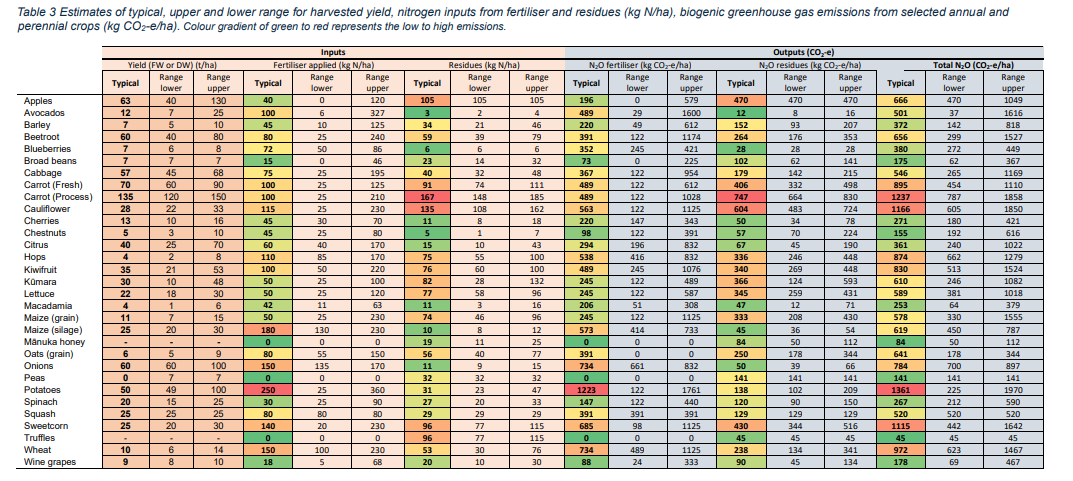Description
Gross biogenic greenhouse gas emissions estimates from growing crops on an average or typical farm or orchard.
Date: June 2024 Version: v1
Owner: Plant & Food Research
Contact: Steve Thomas, Plant & Food Research
Link to report / paper
Greenhouse gas emissions from cropping systems
Preview Image

Dataset attributes
| Spatial extent |
National |
|---|
| Spatial resolution |
|
|---|
| Temporal extent |
|
|---|
| Temporal resolution |
|
|---|
| Evaluation method (Validation) |
Expert assessment |
|---|
| Evaluation result (Numeric) |
|
|---|
| Evaluation result (Categorical) |
|
|---|
| Uncertainty method |
|
|---|
| Uncertainty data format (Numeric) |
|
|---|
| Uncertainty data format (Categorical) |
|
|---|
Methodology
We followed the Aotearoa-New Zealand Greenhouse Gas (GHG) Inventory approach (Ministry for Primary Industries 2022; Ministry for the Environment 2024) to estimate anthropogenic biogenic GHG emissions within the farm or orchard boundary. Direct and indirect N2O emissions from crops were estimated from nitrogen (N) inputs from synthetic fertilisers, returns of crop residues and livestock excreta deposition. Estimates of CH4 emissions from ruminants and manure management were derived from New Zealand inventory data for each livestock type, considering feed intake. For crops already included in the inventory, we utilised previously reported factors (Ministry for Primary Industries 2022). However, for the other crops not included in the Inventory, it was necessary to estimate the N returned from crop residues in addition to the application of synthetic N fertiliser. There is no complete survey of N fertiliser applications to individual crops; national fertiliser input data are normally aggregated to land use type which is appropriate for the Inventory.
We gathered information for synthetic fertiliser N inputs, residue management and grazing through a range of sources. These included published and unpublished literature, industry recommendations, industry and research experts. The availability and reliability of these estimates is highly variable. Ideally, we used Aotearoa-New Zealand data. Where this was not available overseas data was used. Where multiple sources of information were available and similar, we expect derived estimates to be most robust. In most cases there was limited information for residue management, especially for the residue management of perennial crops.
Using the input data and emission factors (EF) from the Inventory we estimated both direct and indirect N2O emissions from soils, and CH4 emissions. Direct N2O emissions are those that are emitted on the farm or orchard from soil, indirect N2O emissions are those from leached or run-off N, or from volatilised N deposited off-site.
To enable comparison of GHG emissions between land uses, N2O and CH4 were converted to CO2 equivalents (CO2-e) using global warming potentials of 265 and 28, respectively, over a 100-year horizon (GWP100) based on the Intergovernmental Panel on Climate Change (IPCC) Fifth Assessment Report (AR5) (IPCC 2014). These values are now used in the latest New Zealand inventory (Ministry for the Environment 2024). Previous inventories used values from the AR4 report (IPCC 2007). GHG emissions are reported on a CO2-e per ha basis and are reported on an annual basis. We annualised the emissions from the crop rotations by dividing the cumulative emissions by the length of the rotation.
##Fitness for purpose / limitations
This table indicates whether the dataset is suitable for different types of questions at different scales.
Note: Users should carefully consider their purpose as this dataset may not be suitable.
|
Operational
| Absolute
| Relative
| Screening/scoping
|
| Block/farm |
No | No | Maybe | Yes |
| Multi-farms(5+) |
No | No | Yes | Yes |
| Catchment |
Maybe | No | Yes | Yes |
| National/regional |
Yes | Yes | Yes | Yes |
Caveat(s) |
Our estimates are indicative rather than absolute. They are based on the best information we had available, much of which relies on experts’ judgements on what are typical inputs and how they might vary. These estimates do provide information that could be used to compare one crop type or rotation with another. Caveats:
- Assumed that the adaptation of the Inventory methodology is appropriate at smaller scales. Uncertainty of N2O emissions is large especially at smaller scales.
- Assumed non-urea N fertiliser was applied. Non-urea based fertiliser has a higher EF compared to urea in Aotearoa. Urea is widely used on a range of annual crops and perennial fruit crops. However, there is insufficient information available to apportion the amounts of urea applied and how these vary with different crops.
- CH4 emissions will vary largely depending on the amount of feed eaten.
|
